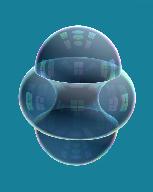

A double bubble and a competitor, called a torus bubble.


Thanks to John Sullivan of the University of Minnesota, for generating these images.
Here are more images of bubbles, at the Scientific Graphics Project SGP at MSRI.
A symmetric torus bubble.
A non-symmetric torus bubble.
In this one the inner Delaunay surface is generated by a curve
that includes a full period, though only
one local maximum and one local minimum.
In tiff format -
Another non-symmetric torus bubble.
In this one the inner Delaunay surface is generated by a curve
For additional pictures of these and other surfaces made by
Jim Hoffman, see
More Images .
that includes several full periods.
You can get a preprint with this result,
written jointly with Roger Schlafly, by sending
me an email request, which you can do by clicking here:
hass@math.ucdavis.edu
Click below to get a copy.
A copy of the C++ source file for this paper is available by clicking above. Instructions for running the code are contained in its introduction. It has been tested on Pentium and UNIX/LINUX machines, and on other machines with a C++ compiler and IEEE 754 floating point arithmetic. It takes about 10 seconds to run on a fast 1999 PC. You will need a C++ compiler to run it. These are found on just about any UNIX or LINUX system.
Here are some links to articles about these results in